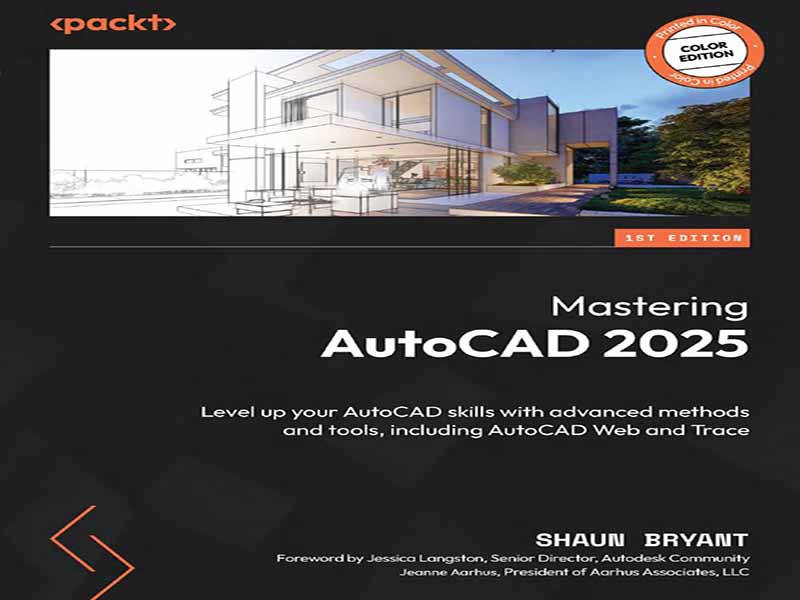- عنوان کتاب: Mastering AutoCAD 2025 – Level up your AutoCAD skills with advanced methods and tools, including AutoCAD Web and Trace
- نویسنده: Shaun Bryant
- حوزه: اتوکد
- سال انتشار: 2025
- تعداد صفحه: 456
- زبان اصلی: انگلیسی
- نوع فایل: pdf
- حجم فایل: 11.8 مگابایت
اتوکد بیش از چهل سال قدمت دارد و نسخههای زیادی داشته است. نسخه کامل اتوکد قابلیتهای طراحی دوبعدی و ابزارهای مدلسازی سهبعدی را ارائه میدهد که میتوانند به صورت حرفهای نورپردازی و رندر شوند و تجسمهای واقعگرایانهای را ارائه میدهند که میتوانند در ارائههای حرفهای گنجانده شوند. میتوان نقشههای دوبعدی دقیقی ایجاد کرد که شامل حاشیهنویسی دقیق طراحی، از جمله ابعاد، خطوط راهنما و جداول داده باشد. این کتاب خواننده را به تسلط بر اتوکد تشویق میکند و تکنیکها و گردشهای کاری را معرفی میکند که به خواننده اجازه میدهد تا با برنامه اتوکد مهارت بیشتری پیدا کند و آنها را قادر میسازد تا از دانش به دست آمده در این کتاب برای بهبود و ارتقای مجموعه مهارتهای اتوکد موجود خود استفاده کنند. این کتاب برای کاربران فعلی اتوکد است که قبلاً در حرفه خود به صورت حرفهای از اتوکد استفاده کردهاند. در حالت ایدهآل، خوانندگان باید از قبل سطح پایهای از دانش اتوکد را داشته باشند تا مفاهیم، گردشهای کاری و فرآیندهای ذکر شده در این کتاب را درک کنند. خوانندگان معمولی شامل تکنسینهای CAD سطح متوسط، مدیران CAD و کسانی هستند که به طور منظم و روزانه از اتوکد استفاده میکنند. فصل 1، سفارشیسازی رابط اتوکد، به رابط اتوکد و نحوه سفارشیسازی سریع و آسان آن میپردازد. با این قابلیت سفارشیسازی، میتوانید تغییرات سریع و آسانی در رابط کاربری اتوکد خود ایجاد کنید تا بهرهوری را افزایش دهید. فصل 2، توسعه فضای کاری اتوکد خودتان، به شما کمک میکند تا یاد بگیرید چگونه از فضاهای کاری در اتوکد به طور مؤثر استفاده کنید و تغییرات لازم در رابط کاربری را برای ایجاد یک فضای کاری سفارشی ایجاد کنید. همچنین یاد خواهید گرفت که چگونه یک فضای کاری که مورد نیاز نیست را حذف کنید. فصل 3، استفاده از رابط اتوکد برای کار هوشمندانهتر، نشان میدهد که چگونه اتوکد توابع و ویژگیهای زیادی را ارائه میدهد که به شما امکان میدهد هوشمندانهتر کار کنید، نه سختتر. این موارد شامل تبهای فایل، تبهای مدل و طرحبندی، تنظیمات پیشنویس در نوار وضعیت، مکعب نمای اتوکد و نوار ناوبری اتوکد میشود. این فصل به شما میآموزد که چگونه از این ابزارها به طور مؤثر استفاده کنید و بهرهوری اتوکد خود را افزایش دهید. فصل 4، استفاده از تنظیمات پیشرفته پیشنویس، در مورد اتوکد و طیف گستردهای از تنظیمات پیشنویس آن که در نوار وضعیت اتوکد قرار دارد صحبت میکند. این فصل شما را با برخی از تنظیمات پیشرفته و کمتر استفاده شده پیشنویس آشنا میکند تا بتوانید با کار هوشمندانهتر، نه سختتر، مؤثرتر و پربارتر کار کنید. فصل ۵، توسعه هندسه پیشرفته با استفاده از Object Snaps، توضیح میدهد که اتوکد یک برنامه طراحی دقیق است و دقت باید در فایلهای طراحی شما حفظ شود. این فصل به شما نشان میدهد که چگونه از تنظیمات خاص طراحی و Object Snaps (که اغلب به عنوان Osnaps شناخته میشوند) استفاده کنید که به شما امکان میدهد تا به طور دقیق و صحیح طراحی و مدلسازی کنید. فصل ۶، اندازهگیری و اصلاح هندسه و اشیاء، برای دستیابی به سطح بالایی از دقت، کاربران اتوکد زمان زیادی را صرف اصلاح هندسه و اشیاء در نقشهها میکنند و اغلب نیاز به اندازهگیری طول، مساحت و زاویه دارند. اتوکد مجموعهای جامع از ابزارهای طراحی و مدلسازی را برای اصلاح و اندازهگیری سریع و دقیق هندسه در فایلهای DWG شما ارائه میدهد. فصل 7، توسعه سبکهای حاشیهنویسی حاشیهنویسی، در این فصل روشهای مورد نیاز برای استفاده از حاشیهنویسی حاشیهنویسی در فایلهای DWG خود، از جمله ایجاد سبکهای متنی برای مدیریت اندازه متن و فونتها، مدیریت حاشیهنویسی ابعاد با سبکهای ابعاد، تنظیم سبکهای خاص رهبر و کار با سبکهای دقیق جدول را خواهید آموخت. فصل 8، کار با مقیاسبندی حاشیهنویسی، این فصل شما را با نحوه استفاده از سبکهای حاشیهنویسی با مقیاسبندی حاشیهنویسی با تنظیم نماها و مقیاسهای مختلف نماها، کار با مقیاسهای حاشیهنویسی در تب Model و اضافه کردن و حذف مقیاسهای حاشیهنویسی اشیاء آشنا میکند. این امر به حاشیهنویسی اجازه میدهد تا به طور مناسب نمایش داده شود تا هدف طراحی را به طور موثر و دقیق منتقل کند. فصل 9، توسعه کتابخانههای بلوک، در پایان این فصل، شما قادر خواهید بود با بلوکهای منظم و پویا در ترسیمات کار کنید و کتابخانههای بلوک خود را با استفاده از روشهای مختلف، از جمله کلیپبورد، ایجاد کنید. همچنین یاد خواهید گرفت که چگونه از پالت بلوکها استفاده کنید و از پالتهای ابزار با بلوکهای خود استفاده کنید. فصل 10، کار با ویژگیهای بلوک، نقشهها با گذشت زمان با بلوکهای بیشتر و بیشتری اشغال میشوند. ویژگیها به شما امکان میدهند بلوکهای خود را شناسایی کنید و اطلاعات ارزشمندی را برای هر کسی که از نقشههای شما استفاده میکند، فراهم کنید. روشهایی که نیاز خواهید داشت در این فصل آمده است، مانند تعریف ویژگیها در یک بلوک، ویرایش ویژگیها در یک بلوک با استفاده از ویرایشگر ویژگی پیشرفته و استفاده از مدیر ویژگی بلوک (BATTMAN). فصل 11، فصل ایجاد یک بلوک پویا با پارامترها و اقدامات، بلوکهای پویا به یک پارامتر و یک اقدام مرتبط نیاز دارند، بنابراین اگر با بلوکی که نمایانگر یک در است کار میکردید، ممکن است لازم باشد یک پارامتر و اقدام برای کنترل جهت چرخش در در باز شدن در در نقشه اضافه کنید. این فصل روشهای کار با آن پارامترها و اقدامات در نقشههای شما را پوشش میدهد. فصل 12، ایجاد یک بلوک پویا با حالتهای دید، حالتهای دید به شما امکان میدهند یک … ایجاد کنید…
AutoCAD is over forty years old and has had many versions. The full version of AutoCAD provides 2D drafting capabilities and 3D modelling tools that can be professionally lit and rendered, providing photo-realistic visualizations that can be incorporated in professional presentations. Precise 2D drawings can be created that include accurate drafting annotation, including dimensions, leaders, and data tables. This book encourages the reader to master AutoCAD, introducing techniques and workflows that allow the reader to become even more competent with the AutoCAD application, empowering them to use the knowledge gained in this book to improve and enhance their existing AutoCAD skill set. This book is for existing users of AutoCAD who have already used AutoCAD professionally in their careers. Ideally, readers should already have a basic level of knowledge of AutoCAD to understand the concepts, workflows, and processes mentioned in this book. Typical readers would include intermediate level CAD technicians, CAD managers, and those who use AutoCAD on a regular daily basis. Chapter 1, Customizing the AutoCAD Interface, looks at the AutoCAD interface and how it can be customized quickly and easily. With this customizability, you can make quick and easy changes to your AutoCAD interface to enhance productivity. Chapter 2, Developing Your Own AutoCAD Workspace, will help you learn how to use workspaces in AutoCAD effectively and make the necessary interface changes to create a custom workspace. You will also learn how to remove a workspace that isn’t needed. Chapter 3, Using the AutoCAD Interface to Work Smarter, shows how AutoCAD provides many functions and features that allow you to work smarter, not harder. These include file tabs, the Model and Layout tabs, drafting settings on the status bar, the AutoCAD ViewCube, and the AutoCAD navigation bar. This chapter teaches you how to use these tools effectively, enhancing your AutoCAD productivity Chapter 4, Using Advanced Drafting Settings, talks about AutoCAD and its extensive range of drafting settings located on the AutoCAD status bar. This chapter will take you through some of the lesser-used, advanced drafting settings so that you can work more effectively and productively by working smarter, not harder. Chapter 5, Developing Advanced Geometry Using Object Snaps, elaborates that AutoCAD is a precise design application, and accuracy must be maintained in your drawing files. This chapter will show you how to use specific drafting settings and object snaps (often referred to as Osnaps) that will allow you to draft and model precisely and accurately Chapter 6, Measuring and Modifying Geometry and Objects, To achieve a high level of accuracy, AutoCAD users spend a lot of time modifying geometry and objects in drawings, often needing to measure lengths, areas, and angles. AutoCAD provides a comprehensive set of drafting and modeling tools to modify and measure the geometry quickly and accurately in your DWG files Chapter 7, Developing Annotative Annotation Styles, This chapter you will learn the methodologies needed to use annotative annotation in your DWG files, including creating text styles to manage text sizes and fonts, managing dimension annotation with dimension styles, setting up specific leader styles, and working with accurate table styles Chapter 8, Working with Annotative Scaling, This chapter takes you through how to utilize annotation styles with annotative scaling by setting up viewports and varying viewport scales, working with annotation scales in the Model tab, and adding and deleting object annotation scales. This allows annotation to be displayed appropriately to communicate design intent effectively and accurately Chapter 9, Developing Block Libraries, By the end of this chapter, you will be able to work with regular and dynamic blocks in drawings and create your own block libraries using various methods, including the Clipboard. You will also learn how to use the Blocks palette and utilize tool palettes with your blocks Chapter 10, Working with Block Attributes, Drawings become occupied with more and more blocks over time. Attributes allow you to identify your blocks and provide valuable information to anyone using your drawings. The methodologies you will need are in this chapter, such as defining attributes within a block, editing attributes in a block using Enhanced Attribute Editor, and using Block Attribute Manager (BATTMAN) Chapter 11, Chapter Creating a Dynamic Block with Parameters and Actions, Dynamic blocks need both a parameter and an associated action, so if you were working with a block representing a door, you may need to add a parameter and action to control the swing direction of the door in the door opening in the drawing. This chapter covers the methodologies for working with those parameters and actions in your drawings. Chapter 12, Creating a Dynamic Block with Visibility States, Visibility states allow you to create a dynamic block with numerous views in the same block. This chapter shows you how to create a washbasin block with three different views: top, front, and side Chapter 13, Sharing Your AutoCAD Drawings, Sharing drawings and drawing views allows you to share aspects of your design in real-time, using the power of the internet and the cloud. This saves valuable drawing management and collaboration time by providing a much more dynamic drawing revision path. Chapter 14, Comparing Drawings and External Reference Files, Comparing drawings and Xrefs is much easier and less time-consuming than it used to be. AutoCAD can compare drawing files and Xref drawing files. This technology also allows you to make a drawing file of the comparison and incorporate the compared objects into the relevant drawing Chapter 15, Working with AutoCAD Web, The AutoCAD subscription comes with the AutoCAD Web offering, which incorporates the AutoCAD web and mobile applications. Both applications allow DWG file collaboration in the cloud, and the AutoCAD mobile application adds full mobility to your DWG files Chapter 16, Collaborating using Traces in AutoCAD, As of AutoCAD 2023, the Trace function is also available in the AutoCAD desktop application and is much enhanced in the AutoCAD 2025 version. This availability provides full trace functionality across all three AutoCAD applications: desktop, web, and mobile.
این کتاب را میتوانید از لینک زیر بصورت رایگان دانلود کنید:
Download: Mastering AutoCAD 2025





































نظرات کاربران